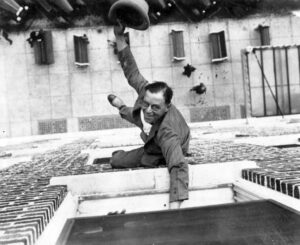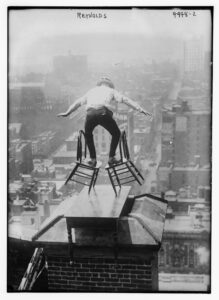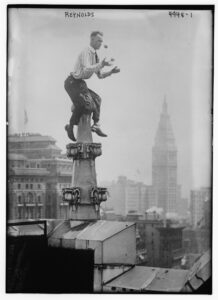 The appearance of three variations of Spider-Man on the big screen has thrilled audiences recently, but Allegany County has had even more spider-men who were real men who scaled buildings often with nothing more than their own strength and agility.
The appearance of three variations of Spider-Man on the big screen has thrilled audiences recently, but Allegany County has had even more spider-men who were real men who scaled buildings often with nothing more than their own strength and agility.
On August 4, 1920, an estimated 10,000 people crammed themselves around the Cumberland Post Office, from the post office to Bedford Street and Centre Street to Mechanic Street. “The tops of buildings were sought as a vantage ground and windows of offices and residences in the vicinity were crowded,” the Cumberland Evening Times reported. It was believed to be the largest crowd ever gathered on the plaza. If they had all been city residents, it would have represented a third of the population crammed into a two-block area.
The Cumberland Boys Band played a short concert for the crowd. Then Mayor Thomas W. Koon walked up steps of the post office and addressed the crowd, telling them they were about to see the exploits of “The Human Fly,” who would climb the outside of the post office.
Then, a 50-year-old man named Harry Gardiner walked up beside the mayor. He wore a white suit, hat, and canvas shoes. He was thin and sinewy. He waved to the crowd, and they went wild.
He walked around the Liberty Street side of the building, stared up at the side of the tall building, grabbed a prominence, and pulled himself off the ground. Then step by step, handhold by handhold, he seemingly crawled up the side of the building. At the top of the first floor, he worked himself around the corner so that he was on the Frederick Street side of the building. 
“At several points the ‘Fly’ stopped and sent a thrill through the throngs below when he drew his hand from the building and stood almost parallel to the wall,” the newspaper reported.
The crowd was quiet except for a few murmurs as they watched Gardiner climb a building many of them said couldn’t be climbed without the aid of ropes and hooks.
Halfway up the building, he paused to throw his hat out into the crowd. At other points, Gardiner stopped to remind the crowd that boys and girls were walking through the crowd with boxes to collect money for the construction of the American Legion Building.
Things became a bit difficult as he neared the roof. He hung on the coping for a few seconds until he was able to swing his legs up and over the edge.
Postmaster Frank Beall greeted him on the roof. Gardiner then scaled the flag pole and waved to the crowd from the top of it. He descended the pole and then walked around the edge of the roof, teasing the crowd by acting as if he was losing his balance. Then he descended the building just as quickly as he crawled up.
Gardiner raised $860 for the American Legion, about $12,000 today. Gardiner was so pleased, he offered to return to Cumberland in September to climb another building for the American Legion convention.
Spiders and flies
 Gardiner was a rare breed of daredevils called “Human Flies” or “Human Spiders” during the first half of the 20th century. These men traveled the country climbing tall buildings and performing other tricks for amazed audiences. The Human Spider and the sponsoring organization split the money collected from the spectators.
Gardiner was a rare breed of daredevils called “Human Flies” or “Human Spiders” during the first half of the 20th century. These men traveled the country climbing tall buildings and performing other tricks for amazed audiences. The Human Spider and the sponsoring organization split the money collected from the spectators.
Gardiner apparently enjoyed making appearances in Allegany County. He was seen here many times over the years. Following his 1920 climb in Cumberland, he traveled up to Frostburg a week later to climb the opera house as a benefit for the Farraday American Legion Post.
Traffic on Main Street was blocked off for two hours to fit the 5,000 spectators who came to watch the climb. The Arion Band entertained the group. Following some opening remarks from Professor Olin Rice, Gardiner began climbing.
“There were no projections on the building, which Gardiner could catch hold of that measured more than two inches,” the Cumberland Evening Times reported. “He was compelled to depend almost entirely on the keystones of the windows of each floor. When the climber reached the cornice of the building he experienced some trouble in getting over, but finally made it by catching at the top with one hand, giving himself extra swings in the air and went over amid deafening cheer from the crowd.”
On his way down, it was getting dark, and he ran into some trouble from loose bricks on the building. He was urged to discontinue the climb, but he managed to finish it. Over $500 was raised for the American Legion.
On August 14, he climbed the Piedmont Opera House for the Kelly-Mansfield American Legion Post.
He returned in September to climb to Fort Cumberland Hotel during the American Legion convention. Gardiner made this same climb in 1925, but this time, he had a surprise for the audience. At the top of the hotel, he showed the crowd of 4,000 a baseball signed by Lefty Grove. Philadelphia Athletics Manager Connie Mack had given Gardiner the ball. Grove was still playing his rookie year and hadn’t developed into the legendary pitcher he would become, but he was a local Major League ball player. Gardiner tossed the ball into the crowd, giving someone in the crowd a unique souvenir.
From Cumberland, Gardiner traveled to Frostburg to climb to the Gunter Hotel to raise funds for the Frostburg Fire Department Building Fund.
He returned to Cumberland in 1927 to climb the Algonquin Hotel blindfolded. At the top of the building, he stood on his head on the edge of the roof. This was done to raise funds for uniforms for the American Legion Drum, Fife & Bugle Corps.
A dangerous life
The life of a human fly was an adventurous one and a dangerous one.
This sense of danger made the climbs exciting for spectators. They never knew whether they were watching an unbelievable act of daring and skill or a man committing suicide. Whether such stunts should be allowed was a headache for local governments that issued permits for such climbs. Some cities had legislation against such stunts, but often ignored them to help a good cause.
In 1924, a week after George Oakley made a climb in Hagerstown, he was in Chambersburg, Penn. While climbing the Chambersburg Trust building, using only a cane and an inner tube, the tube snapped and Oakley fell three stories to the ground. An examination at Chambersburg Hospital showed that Oakley had several broken bones, including lower vertebrae, his pelvis, ribs, left arm and his breast bone, with many of the bones being broken in multiple places. According to The Franklin Repository, his “nervous system suffering much from shock.” He suffered for hours before dying from his injuries the next day.
Oakley had also been in Frostburg earlier in the year to climb the Hotel Gunter. During his climb, he also hung by his legs from the roof of the Lyric Opera House using an inner tube.
Another human fly died from a six-story fall in Baltimore in 1921, and one died from a 10-story fall in New York City in 1923.
Yet, another daredevil was always ready to put his life on the line for the thrill of conquering gravity.
Other county spiders
The first reported human spider in Cumberland was Jack Williams. He climbed the Third National Bank Building on December 12, 1916, before a crowd of several hundred spectators.
Johnny Woods was one of the more daring human flies. In 1944, not only did he climb the Gunter Hotel, but he balanced on a tipped chair on the edge of the roof and walked around the edge of the roof blindfolded. Ten years later, he scaled the Morgan Hotel in Cumberland and rode a bike around the edge of the roof three stories above the ground.
Although many of the famous Human Spiders and Human Flies were active in the first couple decades of the 20th century, Human Fly John Ciampa climbed buildings in the 1940s and early 1950s, Human Spider George Willig climbed the World Trade Center in 1977, and Human Fly Rick Rojatt was a stunt rider in the 1970s. While daredevil stunts still attract attention, they have become increasingly more dangerous. In 2014, Alan Eustace jumped from a spacecraft in space and fell 25.75 miles safely to earth, using only a parachute to slow his descent.
Anything for a thrill.